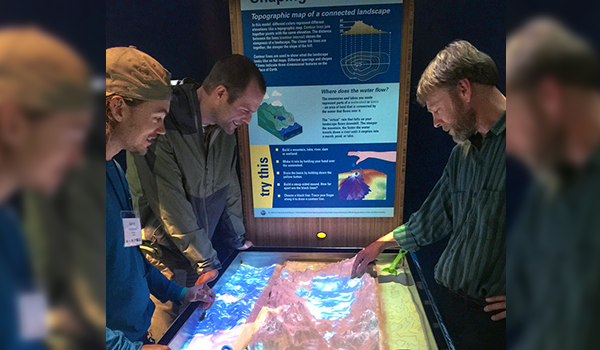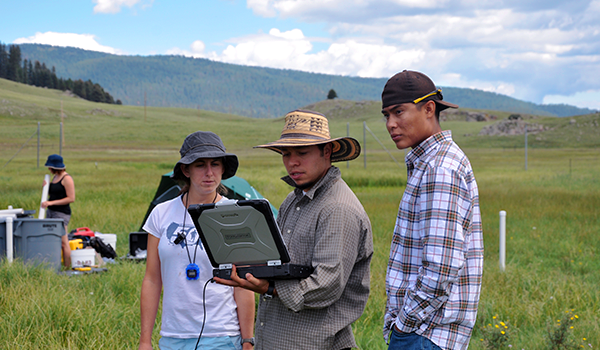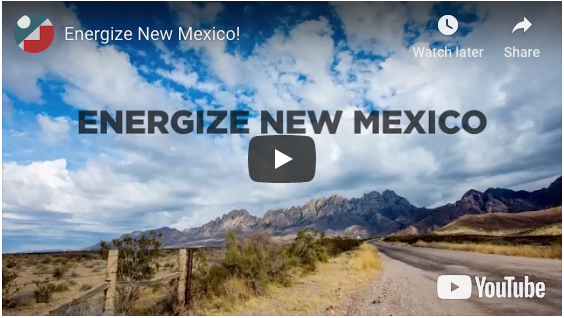History of EPSCoR in NM
2024
-
E-CORE RII: Research Infrastructure Optimization for New Mexico
-
PI: Ganesh Balakrishnan, University of New Mexico
Co-PIs: Lorie Liebrock, Jason Arviso, Patricia Sullivan, and Philip Lister
Award: Track 2; $8,000,000; NSF #2435071This collaborative project is led by the University of New Mexico in collaboration with Navajo Technical University (NTU), New Mexico Tech (NMT), Central New Mexico Community College (CNMCC), and New Mexico State University (NMSU). The Research Infrastructure Optimization for New Mexico (RIO-NM) project seeks to create a more interconnected, inclusive, and innovative research environment. RIO-NM will link the existing research ecosystem in New Mexico with emerging research institutes (ERIs), including Hispanic Serving Institutions (HSIs) and Tribal Colleges and Universities (TCUs). The project focuses on two main areas of need at New Mexico?s ERIs: developing cyberinfrastructure and creation of research pathways. By addressing these needs, RIO-NM will stimulate innovation. In turn, this has potential to lead to economic growth in key sectors resulting in high-value employment opportunities for graduates from ERIs, particularly those from underrepresented groups in science and engineering, thus improving the standard of living in New Mexico. RIO-NM is dedicated to promoting a culture of inclusion and diversity, and expanding participation in the scientific community across various individuals, institutions, and sectors.
2022
-
Laying the Foundation for Scalable Quantum Photonic Technologies
-
PI: Ganesh Balakrishnan, University of New Mexico
Co-PIs: Chitraeema Chakraborty, Matthew Doty, Tara Drake, and Marek Osinski
Award: Track 2; $4,000,000; NSF #2217786This collaborative project will focus on a scalable foundation for quantum photonic technologies. Through this funding, researchers at UNM and UDE will devise a new method of manufacturing quantum photonic emitters which are LED-like devices that generate photonic qubits, the fundamental information unit of quantum science.
2021
-
Tri-state Research Institute of Manufacturing for Managing CO2
-
PI: Xiao-Dong Zhou, University of Louisiana at Lafayette
Co-PIs: Meng Zhou and Delia Valles-Rosales, NMSU; Shuya Wei, UNM
Award: Track 2; $6,000,000; NSF #119688The mission of the Tri-state Research Institute of Manufacturing for Managing CO2 (TRIMMing CO2) project is to address the challenge of carbon capture and utilization through innovative manufacturing processes. The work is enabled by an interdisciplinary network of researchers at the University of Louisiana at Lafayette, New Mexico State University, the University of New Mexico and West Virginia University, as well as the National Energy Technology Laboratory and Idaho National Laboratory.
-
Technology Development for the Next-Generation of Ground-Based Cosmic Microwave
Background Instrumentation at Argonne National Laboratory -
PI: Darcy Barron, University of New Mexico
Award: Track 4; $125,061; NSF #2033199This EPSCoR RII Track 4 fellowship will support work at Argonne National Laboratory on readout development for the next-generation cosmic microwave background project, CMB-S4. Measurements of cosmic microwave background (CMB) are a powerful tool to study and understand our universe.
-
DEPSCoR: A New Paradigm for Transcritical Injection Simulation and Understanding
-
PI: Daniel Banuti, University of New Mexico
Award: $600,000; DEPSCoRThis project will study new ways to understand and simulate high-pressure injection through experiments, models, and simulation in collaboration with the Propulsion Research Center at the University of Alabama in Huntsville.
2020
-
DOE EPSCoR: Data-Science Enabled, Robust and Rapid MeV Ultrafast Electron Diffraction Instrument
System to Characterize Materials Including for Quantum and Energy Applications -
PI: Dr. Sandra Biedron, University of New Mexico
Award: $750,000; DE-SC0021365This three-year award supports UNM collaborations with three DOE laboratories (NM-based Los Alamos National Laboratory (LANL), Brookhaven National Laboratory, and Argonne National Laboratory) and seeks to enhance the mega-electron volt (MeV) ultrafast electron diffraction (MUED) instrument housed in the Brookhaven National Laboratory Accelerator Test Facility.
2018
-
RII-5: New Mexico SMART Grid Center
-
PI: Ganesh Balakrishnan, University of New Mexico
William Michener, University of New Mexico
Award: Track 1; $20,000,000; NSF #1757207
Annual reports: Year 1 (PDF) | Year 2 (PDF) | Year 3 (PDF)A novel, interdisciplinary research center—the New Mexico EPSCoR SMART Grid Center—pursues next-generation electric power production and delivery through a SMART electric grid (one that is Sustainable, Modular, Adaptive, Resilient, and Transactive) and envisions a modern, secure, and sustainable electric grid supported by a diverse, next generation workforce. The New Mexico SMART Grid Center mission is to investigate the fundamental challenges to transition the existing electricity transmission and distribution infrastructure into a SMART grid and develop supporting knowledge, national talent, and an informed public. The New Mexico SMART Grid Center will develop research capacity and education programs to support a modern electric grid built on the principles of distribution feeder microgrids (DFMs), and empower a diverse, next-generation workforce through industry partnerships, education, and public outreach.
-
PI: Christian Carrico, New Mexico Tech
Award: Track 4; $196,830; NSF #1832813This research, Biomass Burning Aerosols in the U.S. Southwest: Hygroscopic Properties from Emissions to Aging, examines the properties of wildfire smoke particulates in laboratory combustion experiments using relevant fuels as well as ambient measurements of smoke aerosols. A particular focus is how these particles interact with atmospheric relative humidity, which changes these optical properties. In the end, parameters measured here are important to understanding the magnitude and extent of smoke impacts; these are also key inputs needed in computer models that predict smoke impacts on air quality and the climate system. The study under this fellowship will allow unparalleled opportunities for the career advancement of the PI and a student.
2017
-
Operando Analysis of Fuel Cell Materials at Advanced Light Source
-
PI: Kateryna Artyushkova, University of New Mexico
Award: Track 4; $201,677; NSF #1738386This project takes on the challenge to advance the knowledge of processes and mechanisms occurring during operation of fuel cells at the atomic and molecular levels. The structure of materials of fuel cells at the nanometer scale of electronic structures will be probed using the instrumentation available at the Advanced Light Source facility, part of Lawrence Berkeley National Laboratory. This opportunity is extending the capacity of scientists and students from the University of New Mexico (UNM) to conduct scientific research in this area. It will allow research faculty and students from UNM to realize New Mexico's potential for sustainable energy development through building a collaboration with state-of-the-science facilities not available at this time within the state of NM. This fellowship will not only support training of the research faculty at the forefront of analytical chemistry but also training of graduate students, thereby creating an opportunity for graduate students to conduct research at the interface between basic and applied science.
2015
-
Focused EPSCoR Collaborations: Developmental Chronnecto-Genomics (Dev-CoG)
-
PI: Vince Calhoun, Georgia State University (formerly University of New Mexico)
Award: Track 2; $5,858,000; NSF #1539067This research project, Developmental Chronnecto-Genomics (Dev-CoG): A Next Generation Framework for Quantifying Brain Dynamics and Related Genetic Factors in Childhood, has The MIND Research Network in New Mexico as the lead and Tulane University, the University of Nebraska Medical Center, and the University of Nebraska, Omaha as partners in a collaboration between 3 jurisdictions. The overarching goal is to understand the rapid development of human brain connectivity that occurs during late childhood and early adolescence. Researchers will use multiple imaging modalities over multiple time scales, and develop novel mathematical algorithms for modeling and data analysis. The project will involve five early career faculty and will engage students from middle school through graduate school in outreach and research activities.
2013
-
RII-4 Energize New Mexico
-
PI: William Michener, University of New Mexico
Award: Track 1; $20,000,000; NSF #1301346
Annual reports: Year 1 (PDF) | Year 2 | Year 3 | Year 4 | Year 5
Museums: Energize New Mexico Exhibitions Final ReportEnergize New Mexico focused on one overarching question with great potential to transform the research enterprise in New Mexico and to promote sustainable development: How can New Mexico realize its energy development potential in a sustainable manner? To answer this question, Energize New Mexico’s goal was to build and strengthen the scientific enterprise that enables New Mexico to harness its abundant renewable energy resources (e.g., solar energy and biofuels), and sustainably capitalize on other resources such as geothermal and uranium reserves, without adversely affecting the environment and the state’s water resources. The infrastructure and activities of Energize New Mexico were designed to support shared-use equipment, engage new research and community college faculty, and support the STEM pipeline by training teachers, undergraduate and graduate students, and post-doctoral fellows. Research findings were communicated broadly through new partnerships with NM's museum network, a citizen-centric web portal, and vibrant, experiential programs targeting K-12 students.
-
Western Consortium for Watershed Analysis, Visualization and Exploration
-
PI: William Michener, University of New Mexico
Award: Track 2; $2,000,000; NSF #1329470 (NM), NSF #1329469 (NV), NSF #1329513 (ID)In order to address the challenge of understanding hydrologic change in high-elevation watersheds, the EPSCoR jurisdictions of Idaho, Nevada, and New Mexico collaborated to create the Western Consortium for Watershed Analysis, Visualization and Exploration (WC-WAVE). WC-WAVE created a virtual watershed (VW) framework to create and integrate watershed models. The VW framework capabilities simulates watershed dynamics, enabling researchers to easily acquire and integrate data, visualize the data to obtain results, and identify environmental consequences of hydrologic changes. Learn more about WC-WAVE at www.westernconsortium.org.

2010
-
C2: Improving Broadband Connectivity for Tribal and Regional Colleges in New Mexico
-
PI: William Michener, University of New Mexico
Award: C2; $1,176,470; NSF #1005886This Research Infrastructure Improvement Inter-Campus and Intra-Campus Cyber Connectivity project was led by New Mexico EPSCoR and was designed to improve cyberinfrastructure at Western New Mexico University (WNMU), Northern New Mexico University (NNMU), and the Navajo Technical College (NTC). The campus network improved reliability and security, enabling development of an integrated library search and retrieval system and increasing student access to collaboration technologies and online research tools. The upgrade facilitated deployment of the campus gateway connection to the New Mexico Computing Applications Center, and enhanced synergy among NSF EPSCoR Research Infrastructure Improvement Track-1 and Track-2 research efforts in the areas of climate and water resources.
2009
-
Cyberinfrastructure Development in the Western Consortium of Idaho, Nevada, and New Mexico
-
PIs: William Michener, University of New Mexico; Gayle Dana, Desert Research Institute; Lucas Sheneman, University of Idaho
Award: Track 2; $2,000,000; NSF #0918635 (NM), NSF #0919123 (NV) , NSF #0919514 (ID)Idaho, Nevada, and New Mexico NSF EPSCoR joined programs forming a consortium of EPSCoR states with similar research agendas related to climate change and water resources. The consortium model significantly increases opportunities for scientific collaboration and enhances each state's ability to secure competitive funding and tackle complex climate change research agendas. The vision of the Western Consortium for Cyberinfrastructure Development was to transform communication, climate change science, and education in our tri-state region.
2008
-
RII-3: Climate Change Impacts on New Mexico's Mountain Sources of Water
-
PI: William Michener, University of New Mexico
Award: Track 1; $15,000,000; NSF #0814449This research infrastructure award addressed the influence of large scale atmospheric circulations on regional and local atmospheric processes and explored how hydrometeorological fluctuations propagate into changes in surface flows downstream. The research performed contributed to the overall understanding and forecasting the effects of climate change on water supply and water quality in arid regions. In New Mexico, climate changes are altering processes associated with water supply, which sustains New Mexico’s economy and determines, to a large extent, the quality of life. This multidisciplinary effort transformed climate change science and policymaking in New Mexico by providing the tools required for quantitative, science-driven discussion of difficult water policy options facing the state, and created a citizenry that is informed about climate change and its impact on natural resources.

2005
-
RII-2: NM NEW
-
PI: Barbara Kimbell, University of New Mexico
Award: Track 1; $7,312,499; NSF #0447691The NM NEW grant focused on two topics: nanoscience and hydrology. In hydrology, the goal was for New Mexico to become a leader in instrumentation and algorithm development for hydraulic modeling and Evapotranspiration (ET) estimation in semi-arid environments. The nanoscience focus consisted of two groups: nano-water and nanomaterials. The nano-water interface group studied the structure and properties of water and aqueous solutions that are confined to or in contact with nanostructured materials, and the nanomaterials energy systems group explored how nanomaterials and nanoscale phenomena can be used for energy production, conversion and storage. Outcomes include: a new UNM Graduate Program in Nanoscience and Microsystems (approved by the UNM board of Regents in September 2006 and by the New Mexico Board of Higher Education in January of 2007); a standardized, state-of-the-art ET network for natural and agricultural systems important for New Mexico; 9 new nanotechnology instruments at 5 universities and 1 community college; a supercomputer cluster for nanoscience research at UNM, available to EPSCoR researchers statewide; and establishment of the Center for Biomedical Engineering at UNM.
2002
-
RII-1: Natural Resources, Biodiversity, and Nanoscience
-
PI: James Gosz, University of New Mexico
Award: Track 1; $6,259,280; NSF #0132632The goal of the first NM EPSCoR Track 1 grant was to remove barriers to competitive research and related educational and economic development, while strengthening the research infrastructure of natural resource management and nanoscience in organizations and universities across the state. In addition to faculty hires, the grant achieved the following outcomes: established a statewide Institute of Resource Analysis and Management (INRAM) with accessibility of new knowledge in mind to the scientific community and the general public; established the Laboratory for Environmental Spacial Analysis at New Mexico State University (NMSU) capable of synthesizing useful data products; created a Laboratory for Environmental Chemistry (LEC) at NMSU, a centralized, modern facility with EPSCoR-funded equipment for chemical analysis of environmental samples; and purchased the first high resolution field emission scanning electron microscope in the state, housed at UNM.
2000
-
PI: James Gosz, University of New Mexico
Award: $229,322; NSF #0090195The Track 1 NSF EPSCoR Planning Grant was awarded to the state of New Mexico to help set priorities for the improvement of science and engineering infrastructure statewide. This planning grant collected data, established a state steering committee, selected targeted EPSCoR research themes and subprograms, and developed a process for selecting a state EPSCoR Project Director(s). The planning activity resulted in submission of an EPSCoR Implementation Proposal for sustainable infrastructure improvements which enabled New Mexico researchers to more effectively compete for federal and private R&D funding.
